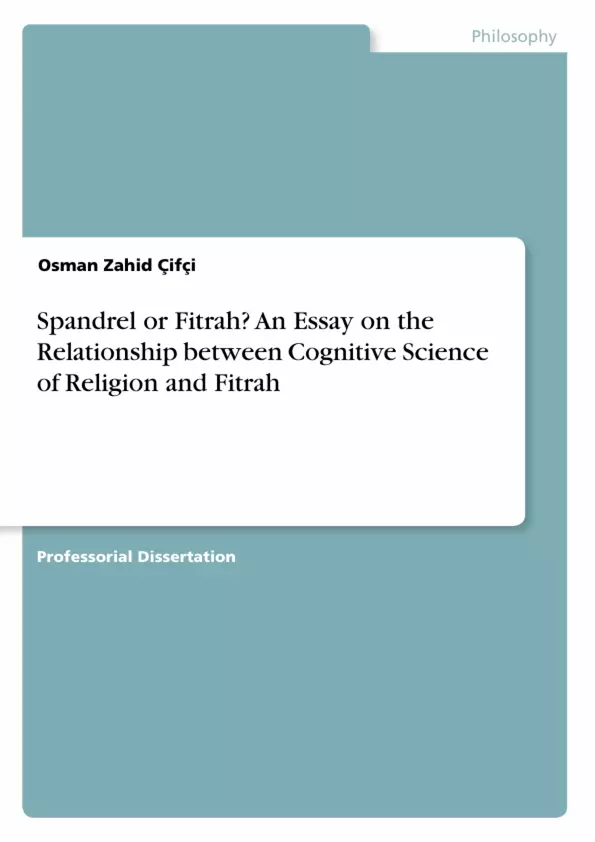This paper analyzes the two concepts of "spandrel" and "fitrah" in the context of the Cognitive Science of Religion and, opposed to that, evolutionary thinking. Despite that the two concepts in this study's title seem to have the same meaning, they are understood differently due to differences in perspective. Both concepts acknowledge that human beings have certain innate faculties and claim that these faculties predispose them to believe and be moral. Spandrel argues that these innate faculties are a result of adaptations that enable us to survive in the evolutionary process, while "fitrah" asserts that these faculties are given by God.
In the study, first, the experimental studies proposed by the proponents of the idea of spandrel and the general ideas of the Cognitive Science of Religion (CSR) are given. Then, it has been established, through experimental tests, that these faculties, proposed by this theory, have similar aspects with the "Commonsense Principles" put forward by Thomas Reid, and his epistemological views have been conveyed. According to him, we should rely on the information provided by these faculties and accept that they are essential for reasoning. After these determinations were made, the study argued that the concept of "fitrah" aligns with the idea of the Cognitive Science of Religion (CSR) and Thomas Reid's views.
Inhaltsverzeichnis (Table of Contents)
- Preface
Zielsetzung und Themenschwerpunkte (Objectives and Key Themes)
The main objective of this essay is to explore the relationship between the Cognitive Science of Religion (CSR) and the concept of "fitrah," contrasting it with the "spandrel" theory. The study investigates whether innate human faculties predisposing belief and morality are a result of evolutionary adaptation (spandrel) or a divine gift ("fitrah").
- Cognitive Science of Religion (CSR)
- The concept of "fitrah"
- The "spandrel" theory in evolutionary biology
- Thomas Reid's Commonsense Principles and their epistemological implications
- The inherent human propensity for belief in the supernatural
Zusammenfassung der Kapitel (Chapter Summaries)
Preface: This preface introduces the core question of the essay: whether innate human faculties related to belief and morality are best explained by the evolutionary concept of "spandrel" or the theological concept of "fitrah." It highlights the differing perspectives on the origin of these faculties and outlines the study's approach. The study will first examine the experimental studies and general ideas of the Cognitive Science of Religion (CSR) and then connect these to Thomas Reid’s epistemological views and the concept of “fitrah.” The author explains his motivation for the study, stemming from a recognition of the universality of belief in supernatural powers throughout human history and his observation of the compatibility between "fitrah" and CSR. The expanded scope from an article to a book is also mentioned, along with acknowledgments to the author's wife and editor.
Schlüsselwörter (Keywords)
Philosophy of Religion, Evolution, Cognitive Science of Religion, Spandrel, Fitrah, Innate Faculties, Belief, Morality, Thomas Reid, Commonsense Principles, Epistemology.
Frequently Asked Questions: A Comprehensive Language Preview
What is the main topic of this essay?
The essay explores the relationship between the Cognitive Science of Religion (CSR) and the concept of "fitrah," comparing it to the "spandrel" theory. It investigates whether innate human faculties predisposing belief and morality are a result of evolutionary adaptation or a divine gift.
What are the key themes explored in this essay?
Key themes include the Cognitive Science of Religion (CSR), the concept of "fitrah," the "spandrel" theory in evolutionary biology, Thomas Reid's Commonsense Principles and their epistemological implications, and the inherent human propensity for belief in the supernatural.
What is the objective of this essay?
The main objective is to analyze whether innate human faculties related to belief and morality are better explained by evolutionary theory ("spandrel") or by the theological concept of "fitrah."
What is the "fitrah" concept?
The essay examines "fitrah" as a theological concept representing a divine gift or innate predisposition towards belief and morality, contrasting it with the evolutionary explanation.
What is the "spandrel" theory?
The "spandrel" theory, borrowed from evolutionary biology, proposes that certain traits, including those related to belief and morality, might be byproducts of evolutionary processes rather than direct adaptations.
What is the role of Thomas Reid's philosophy?
Thomas Reid's Commonsense Principles and their epistemological implications are explored in relation to the inherent human propensity for belief and morality, providing a philosophical framework for the discussion.
What does the preface include?
The preface introduces the central research question, highlighting the contrasting perspectives on the origin of innate faculties related to belief and morality ("fitrah" vs. "spandrel"). It also outlines the essay's approach, motivation, and scope.
What are the chapter summaries provided?
The provided HTML includes a summary of the preface, introducing the core question and outlining the essay's approach. Summaries of other chapters are not included in this preview.
What are the keywords associated with this essay?
Keywords include Philosophy of Religion, Evolution, Cognitive Science of Religion, Spandrel, Fitrah, Innate Faculties, Belief, Morality, Thomas Reid, Commonsense Principles, and Epistemology.
- Citation du texte
- Osman Zahid Çifçi (Auteur), 2023, Spandrel or Fitrah? An Essay on the Relationship between Cognitive Science of Religion and Fitrah, Munich, GRIN Verlag, https://www.grin.com/document/1330560



